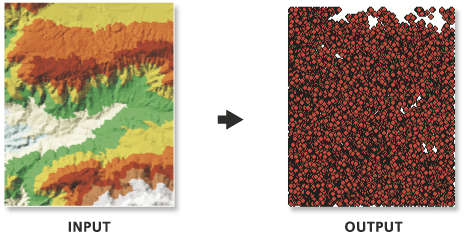| 标注 | 说明 | 数据类型 |
输入 TIN | 待处理的 TIN 数据集。 | TIN Layer |
输出要素类 | 将生成的要素类。 | Feature Class |
点字段 (可选) | 输出要素类的高程属性字段的名称。如果指定名称,要素类将是 2D 的;否则,要素类将是 3D 的。默认情况下不提供名称,因此会创建 3D 点要素。 | String |
标签值字段 (可选) | 将标签属性存储在输出要素类中的字段的名称。默认情况下,不创建任何标签值字段。 | String |
摘要
可将不规则三角网 (TIN) 数据集的结点导出到点要素类。
插图

使用情况
填充点字段参数的名称可创建 2D 点要素类。忽略名称可创建 3D 点。
- 如果 TIN 已为其三角形指定了标签值,则点会将这些值作为属性,方式如下:在标签值字段参数中指定名称。没有明确指定标签值的结点都将采用值 0。
参数
arcpy.ddd.TinNode(in_tin, out_feature_class, {spot_field}, {tag_field})| 名称 | 说明 | 数据类型 |
in_tin | 待处理的 TIN 数据集。 | TIN Layer |
out_feature_class | 将生成的要素类。 | Feature Class |
spot_field (可选) | 输出要素类的高程属性字段的名称。如果指定名称,要素类将是 2D 的;否则,要素类将是 3D 的。默认情况下不提供名称,因此会创建 3D 点要素。 | String |
tag_field (可选) | 将标签属性存储在输出要素类中的字段的名称。默认情况下,不创建任何标签值字段。 | String |
代码示例
下面的示例演示了如何在 Python 窗口中使用此工具。
arcpy.env.workspace = 'C:/data'
arcpy.TinNode_3d('tin', 'elevation_node.shp', spot_field='Elevation')下面的示例演示了如何在独立 Python 脚本中使用此工具。
"""****************************************************************************
Name: Create Terrain from TIN
Description: This script demonstrates how to create a terrain dataset using
features extracted from a TIN. It is particularly useful in
situations where the source data used in the TIN is not available,
and the amount of data stored in the TIN proves to be too large
for the TIN. The terrain's scalability will allow improved
display performance and faster analysis. The script is designed
to work as a script tool with 5 input arguments.
****************************************************************************"""
# Import system modules
import arcpy
# Set local variables
tin = arcpy.GetParameterAsText(0) # TIN used to create terrain
gdbLocation = arcpy.GetParameterAsText(1) # Folder that will store terran GDB
gdbName = arcpy.GetParameterAsText(2) # Name of terrain GDB
fdName = arcpy.GetParameterAsText(3) # Name of feature dataset
terrainName = arcpy.GetParameterAsText(4) # Name of terrain
try:
# Create the file gdb that will store the feature dataset
arcpy.management.CreateFileGDB(gdbLocation, gdbName)
gdb = '{0}/{1}'.format(gdbLocation, gdbName)
# Obtain spatial reference from TIN
SR = arcpy.Describe(tin).spatialReference
# Create the feature dataset that will store the terrain
arcpy.management.CreateFeatureDataset(gdb, fdName, SR)
fd = '{0}/{1}'.format(gdb, fdName)
# Export TIN elements to feature classes for terrain
arcpy.AddMessage("Exporting TIN footprint to define terrain boundary...")
boundary = "{0}/boundary".format(fd)
# Execute TinDomain
arcpy.ddd.TinDomain(tin, tinDomain, 'POLYGON')
arcpy.AddMessage("Exporting TIN breaklines...")
breaklines = "{0}/breaklines".format(fd)
# Execute TinLine
arcpy.ddd.TinLine(tin, breaklines, "Code")
arcpy.AddMessage("Exporting TIN nodes...")
masspoints = "{0}/masspoints".format(fd)
# Execute TinNode
arcpy.ddd.TinNode(sourceTIN, TIN_nodes)
arcpy.AddMessage("Creating terrain dataset...")
terrain = "terrain_from_tin"
# Execute CreateTerrain
arcpy.ddd.CreateTerrain(fd, terrainName, 10, 50000, "",
"WINDOWSIZE", "ZMEAN", "NONE", 1)
arcpy.AddMessage("Adding terrain pyramid levels...")
terrain = "{0}/{1}".format(fd, terrainName)
pyramids = ["20 5000", "25 10000", "35 25000", "50 50000"]
# Execute AddTerrainPyramidLevel
arcpy.ddd.AddTerrainPyramidLevel(terrain, "", pyramids)
arcpy.AddMessage("Adding features to terrain...")
inFeatures = "{0} Shape softclip 1 0 10 true false boundary_embed <None> "\
"false; {1} Shape masspoints 1 0 50 true false points_embed "\
"<None> false; {2} Shape softline 1 0 25 false false lines_embed "\
"<None> false".format(boundary, masspoints, breaklines)
# Execute AddFeatureClassToTerrain
arcpy.ddd.AddFeatureClassToTerrain(terrain, inFeatures)
arcpy.AddMessage("Building terrain...")
# Execute BuildTerrain
arcpy.ddd.BuildTerrain(terrain, "NO_UPDATE_EXTENT")
arcpy.GetMessages()
except arcpy.ExecuteError:
print(arcpy.GetMessages())
except Exception as err:
print(err)许可信息
- Basic: 需要 3D Analyst
- Standard: 需要 3D Analyst
- Advanced: 需要 3D Analyst